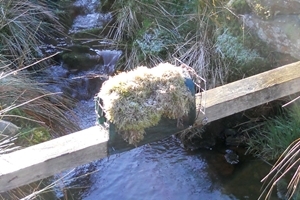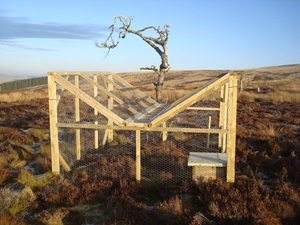Predation control is a key component of grouse moor management and plays an important part in the conservation benefits it brings. Although this sometimes causes controversy, the benefits to both red grouse and other species are well recognised. This chapter explains the methods used and the impacts of predator control on moorland.
Q: What is meant by “legal predator control”?
 A: Lethal control of certain common generalist predator species is allowed under UK law, without individual licences. The methods used are regulated by legislation and are also guided by best practice codes.
A: Lethal control of certain common generalist predator species is allowed under UK law, without individual licences. The methods used are regulated by legislation and are also guided by best practice codes.
Q: Is predator control only done on grouse moors?
A: No. Gamekeepers are not alone in controlling predators; many conservation bodies control them for the protection of wildlife. Foxes and crows are also controlled to protect lambs and breeding ewes.
Q: What predator species are controlled?
A: The main species controlled on moorland are foxes, carrion and hooded crows but also stoats, weasels, rats and feral cats. The abundance of different predators varies between regions, so the number controlled of each, and the effort directed towards controlling different species, will also vary according to which are relevant in that area.
Q: How are they controlled?
A: Predators are controlled using a variety of methods appropriate to local conditions, typically shooting and various forms of trapping. The aim is to achieve humane management of the predator species. A new range of humane spring traps are being brought in for stoats, weasels and rats and these are used in a variety of settings such as in walls or over ditches. Cage traps of various designs (Larsen and multi-catch) are typically used for corvids. Non-lethal restraining snares are used for foxes. Shooting, often at night, is commonly used for foxes.
These are all regulated activities in the UK, with training recommended in all regions and mandatory in some parts of the UK. Where predation is controlled, it should be done effectively, so that the prey species benefits. It must be carried out humanely and it must be selective, targeting the species in question and avoiding non-target species as effectively as possible. Best practice is continuously researched and revised by the GWCT.
Q: Why is predator control necessary?
A: The modern world has created an environment where generalist predators (those that take many different kinds of prey) thrive - sometimes to the extent that they can harm the conservation status of other species. For example, a recent review of five wader species in western Europe (oystercatcher, lapwing, black-tailed godwit, curlew and redshank) found that nest predation has increased by around 40% in the last four decades. Although adult survival remains high for these species, chick survival and nest success have both declined, and breeding numbers are falling.
Q: Why do we control some species for the benefit of others?
A: Many years of practice and GWCT research show that reducing the number of predators can improve the breeding success and abundance of prey species. Predator control is typically the lethal control of predators to achieve this goal. Game shoots use this to produce a sustainable harvest of game, and species living in the same habitat as the game often benefit from this reduced predation.
Q: Are predator numbers permanently reduced?
A: Predator species which can be legally controlled in the UK are typically widespread and common, and there is no current concern for their conservation status. In most cases, the effect of predator control on their population is often local and easily reversed. Predation control is typically needed year on year, because as the species in question are generally abundant, those that are removed are usually replaced through breeding, or immigration from nearby areas. However, where predator control is widely practised across large regions, for example where there are adjacent grouse moors, predator numbers can be suppressed on a broader scale. We need to be mindful to ensure that the conservation status of predator species is not impaired.
Q: Do predators really have such a large impact on prey populations?
A: In some circumstances, yes. Since the early 1980s, the GWCT has carried out many research projects looking at the effects of predation, publishing numerous scientific papers in this area. These clearly show that predation can depress numbers of game and other wildlife, especially when prey are scarce relative to predator numbers. Both breeding success, and longer-term abundance can be lowered by predation. This reduced abundance is caused by losses of adults, eggs or young. A recent scientific review paper found good evidence that predation is having an effect on the populations of ground-nesting seabirds, waders and gamebirds.
Q: Does reducing predators help those vulnerable species?
 A: It can, where predator control is done to an effective level and habitat is suitable. As well as improving habitat and controlling diseases, much of the benefit of grouse moor management, particularly for grouse, waders, and probably mountain hares, comes from legal predator control. An experimental test of predator control showed that it allowed some ground-nesting birds (lapwing, golden plover, curlew, red grouse and meadow pipit) to breed on average three times more effectively than when predators were not controlled, with knock-on effects for breeding numbers in subsequent years.
A: It can, where predator control is done to an effective level and habitat is suitable. As well as improving habitat and controlling diseases, much of the benefit of grouse moor management, particularly for grouse, waders, and probably mountain hares, comes from legal predator control. An experimental test of predator control showed that it allowed some ground-nesting birds (lapwing, golden plover, curlew, red grouse and meadow pipit) to breed on average three times more effectively than when predators were not controlled, with knock-on effects for breeding numbers in subsequent years.
In this experiment, the benefit to breeding curlew numbers was marked. In the absence of predator control, curlew numbers fell by 17% per year. When legal predator control was implemented, curlew numbers rose by 14% per year (after a lag period as the new chicks reached breeding age). We have calculated that the low breeding success seen on moors where predators were not controlled in this experiment could in theory lead to a 47% drop in curlew numbers of after ten years, with an 81% reduction for both lapwing and golden plover.
This is currently being assessed through repeat surveys. Bird monitoring at Langholm Moor since 1992 has also shown that breeding success for red grouse and hen harriers was lower when predators were not controlled, with numbers declining during this period for these two species as well as for some breeding waders.
When keepering was restored, breeding success for these two species rose again, along with increased numbers of merlin, curlew, golden plover and snipe. A review of the literature on the effects of predator removal on gamebirds and ground-nesting birds found that predator control can increase breeding numbers, hatching and fledging success, and can be an effective conservation strategy for enhancing bird populations.